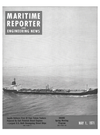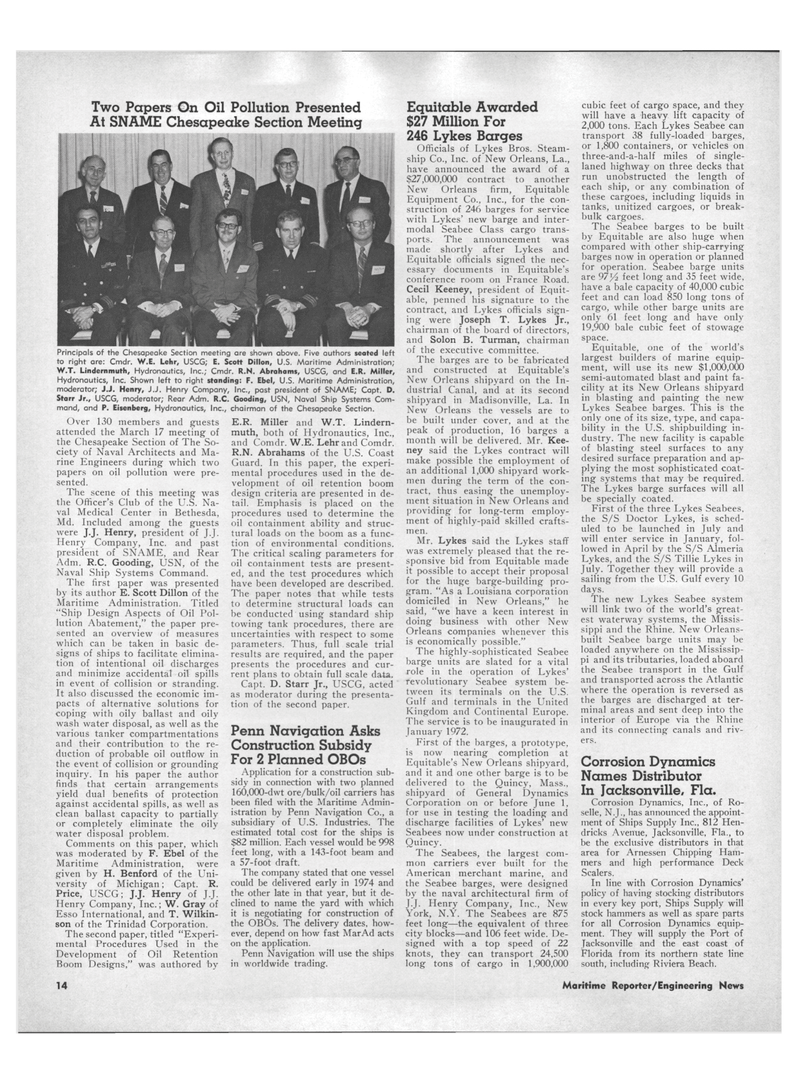
Page 12: of Maritime Reporter Magazine (May 1971)
Read this page in Pdf, Flash or Html5 edition of May 1971 Maritime Reporter Magazine
Two Papers On Oil Pollution Presented
At SNAME Chesapeake Section Meeting
Principals of the Chesapeake Section meeting are shown above. Five authors seated left to right are: Cmdr. W.E. Lehr, USCG; E. Scott Dillon, U.S. Maritime Administration;
W.T. Lindernmuth, Hydronautics, Inc.; Cmdr. R.N. Abrahams, USCG, and E.R. Miller,
Hydronautics, Inc. Shown left to right standing: F. Ebel, U.S. Maritime Administration, moderator; J.J. Henry, J.J. Henry Company, Inc., past president of SNAME; Capt. D.
Starr Jr., USCG, moderator; Rear Adm. R.C. Gooding, USN, Naval Ship Systems Com- mand, and P. Eisenberg, Hydronautics, Inc., chairman of the Chesapeake Section.
Over 130 members and guests attended the March 17 meeting of the Chesapeake Section of The So- ciety of Naval Architects and Ma- rine Engineers during which two papers on oil pollution were pre- sented.
The scene of this meeting was the Officer's Club of the U.S. Na- val Medical Center in Bethesda,
Md. Included among the guests were J.J. Henry, president of J.J.
Henry Company, Inc. and past president of SNAME, and Rear
Adm. R.C. Gooding, USN, of the
Naval Ship Systems Command.
The first paper was presented by its author E. Scott Dillon of the
Maritime Administration. Titled "Ship Design Aspects of Oil Pol- lution Abatement," the paper pre- sented an overview of measures which can be taken in basic de- signs of ships to facilitate elimina- tion of intentional oil discharges and minimize accidental oil spills in event of collision or stranding.
It also discussed the economic im- pacts of alternative solutions for coping with oily ballast and oily wash water disposal, as well as the various tanker compartmentations and their contribution to the re- duction of probable oil outflow in the event of collision or grounding inquiry. In his paper the author finds that certain arrangements yield dual benefits of protection against accidental spills, as well as clean ballast capacity to partially or completely eliminate the oily water disposal problem.
Comments on this paper, which was moderated by F. Ebel of the
Maritime Administration, were given by H. Benford of the Uni- versity of Michigan; Capt. R.
Price, USCG; J.J. Henry of J.J.
Henry Company, Inc.; W. Gray of
Esso International, and T. Wilkin- son of the Trinidad Corporation.
The second paper, titled "Experi- mental Procedures Used in the
Development of Oil Retention
Boom Designs," was authored by
E.R. Miller and W.T. Lindern- muth, both of Hydronautics, Inc., and Comdr. W.E. Lehr and Comdr.
R.N. Abrahams of the U.S. Coast
Guard. I n this paper, the experi- mental procedures used in the de- velopment of oil retention boom design criteria are presented in de- tail. Emphasis is placed on the procedures used to determine the oil containment ability and struc- tural loads on the boom as a func- tion of environmental conditions.
The critical scaling parameters for oil containment tests are present- ed, and the test procedures which have been developed are described.
The paper notes that while tests to determine structural loads can be conducted using standard ship towing tank procedures, there are uncertainties with respect to some parameters. Thus, full scale trial results are required, and the paper presents the procedures and cur- rent plans to obtain full scale data.
Capt. D. Starr Jr., USCG, acted as moderator during the presenta- tion of the second paper.
Penn Navigation Asks
Construction Subsidy
For 2 Planned OBOs
Application for a construction sub- sidy in connection with two planned 160,000-dwt ore/bulk/oil carriers has been filed with the Maritime Admin- istration by Penn Navigation Co., a subsidiary of U.S. Industries. The estimated total cost for the ships is $82 million. Each vessel would be 998 feet long, with a 143-foot beam and a 57-foot draft.
The company stated that one vessel could be delivered early in 1974 and the other late in that year, but it de- clined to name the yard with which it is negotiating for construction of the OBOs. The delivery dates, how- ever, depend on how fast Mar Ad acts on the application.
Penn Navigation will use the ships in worldwide trading.
Equitable Awarded $27 Million For 246 Lykes Barges
Officials of Lykes Bros. Steam- ship Co., Inc. of New Orleans, La., have announced the award of a $27,000,000 contract to another
New Orleans firm, Equitable
Equipment Co., Inc., for the con- struction of 246 barges for service with Lykes' new barge and inter- modal Seabee Class cargo trans- ports. The announcement was made shortly after Lykes and
Equitable officials signed the nec- essary documents in Equitable's conference room on France Road.
Cecil Keeney, president of Equit- able, penned his signature to the contract, and Lykes officials sign- ing were Joseph T. Lykes Jr., chairman of the board of directors, and Solon B. Turman, chairman of the executive committee.
The barges are to be fabricated and constructed at Equitable's
New Orleans shipyard on the In- dustrial Canal, and at its second shipyard in Madisonville, La. In
New Orleans the vessels are to be built under cover, and at the peak of production, 16 barges a month will be delivered. Mr. Kee- ney said the Lykes contract will make possible the employment of an additional 1,000 shipyard work- men during the term of the con- tract, thus easing the unemploy- ment situation in New Orleans and providing for long-term employ- ment of highly-paid skilled crafts- men.
Mr. Lykes said the Lykes staff was extremely pleased that the re- sponsive bid from Equitable made it possible to accept their proposal for the huge barge-building pro- gram. "As a Louisiana corporation domiciled in New Orleans," he said, "we have a keen interest in doing business with other New
Orleans companies whenever this is economically possible."
The highly-sophisticated Seabee barge units are slated for a vital role in the operation of Lykes' revolutionary Seabee system be- tween its terminals on the U.S.
Gulf and terminals in the United
Kingdom and Continental Europe.
The service is to be inaugurated in
January 1972.
First of the barges, a prototype, is now nearing completion at
Equitable's New Orleans shipyard, and it and one other barge is to be delivered to the Quincy, Mass., shipyard of General Dynamics
Corporation on or before June 1, for use in testing the loading and discharge facilities of Lykes' new
Seabees now under construction at
Quincy.
The Seabees, the largest com- mon carriers ever built for the
American merchant marine, and the Seabee barges, were designed by the naval architectural firm of
J.J. Henry Company, Inc., New
York, N.Y. The Seabees are 875 feet long—the equivalent of three city blocks—and 106 feet wide. De- signed with a top speed of 22 knots, they can transport 24,500 long tons of cargo in 1,900,000 cubic feet of cargo space, and they will have a heavy lift capacity of 2,000 tons. Each Lykes Seabee can transport 38 fully-loaded barges, or 1,800 containers, or vehicles on three-and-a-half miles of single- laned highway on three decks that run unobstructed the length of each ship, or any combination of these cargoes, including liquids in tanks, unitized cargoes, or break- bulk cargoes.
The Seabee barges to be built by Equitable are also huge when compared with other ship-carrying barges now in operation or planned for operation. Seabee barge units are 97l/i feet long and 35 feet wide, have a bale capacity of 40,000 cubic feet and can load 850 long tons of cargo, while other barge units are only 61 feet long and have only 19,900 bale cubic feet of stowage space.
Equitable, one of the world's largest builders of marine equip- ment, will use its new $1,000,000 semi-automated blast and paint fa- cility at its New Orleans shipyard in blasting and painting the new
Lykes Seabee barges. This is the only one of its size, type, and capa- bility in the U.S. shipbuilding in- dustry. The new facility is capable of blasting steel surfaces to any desired surface preparation and ap- plying the most sophisticated coat- ing systems that may be required.
The Lykes barge surfaces will all be specially coated.
First of the three Lykes Seabees, the S/S Doctor Lykes, is sched- uled to be launched in July and will enter service in January, fol- lowed in April by the S/S Almeria
Lykes, and the S/S Tillie Lykes in
July. Together they will provide a sailing from the U.S. Gulf every 10 days.
The new Lykes Seabee system will link two of the world's great- est waterway systems, the Missis- sippi and the Rhine. New Orleans- built Seabee barge units may be loaded anywhere on the Mississip- pi and its tributaries, loaded aboard the Seabee transport in the Gulf and transported across the Atlantic where the operation is reversed as the barges are discharged at ter- minal areas and sent deep into the interior of Europe via the Rhine and its connecting canals and riv- ers.
Corrosion Dynamics
Names Distributor
In Jacksonville, Fla.
Corrosion Dynamics, Inc., of Ro- selle, N.J., has announced the appoint- ment of Ships Supply Inc., 812 Hen- dricks Avenue, Jacksonville, Fla., to be the exclusive distributors in that area for Arnessen Chipping Ham- mers and high performance Deck
Scalers.
In line with Corrosion Dynamics' policy of having stocking distributors in every key port, Ships Supply will stock hammers as well as spare parts for all Corrosion Dynamics equip- ment. They will supply the Port of
Jacksonville and the east coast of
Florida from its northern state line south, including Riviera Beach. 14 Maritime Reporter/Engineering News

 11
11

 13
13
